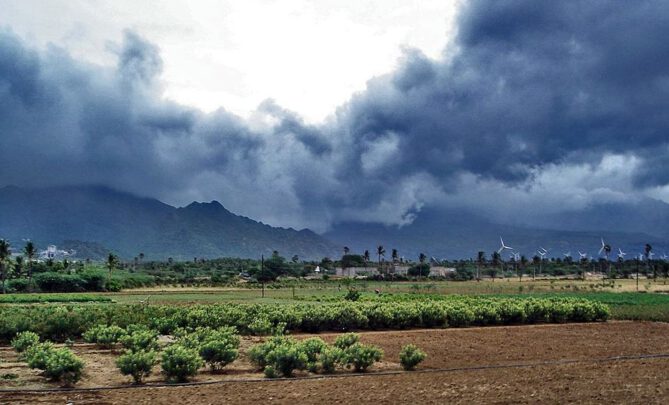Increased Methane emissions from summer Monsoon

Advancing monsoon clouds and showers in Aralvaimozhy, near Nagercoil, India (2006).
Eastern Afghanistan and neighbouring Pakistan have been hit by torrential rain, causing floods which have killed at least 80 people.
The region has suffered devastating floods during the monsoon period for the past three years. High methane in North Africa, Middle East and South Asia. The upper tropospheric methane continues to build.
The MODIS image below reveals concentrations as high as 2340 ppbv in this area at 218 mb or approximately 36,850 feet altitude August 5, 2013. Parts of the Methane could be originating from current flooding in the northern regions of Afghanistan and or Pakistan.
And as the following study explains could help explain the observed large increase of biogenic methane – which can occur in anaerobic environments.
Estimating the contribution of monsoon-related biogenic production to methane emissions from South Asia using CARIBIC observations
Key Points
- Observed large increase in S. Asian methane emissions during the summer monsoon
- Sources identified as biogenic, releasing ~15.8 Tg of additional methane
- Accounts for ~50% of total June-Sept methane emissions
During the summer monsoon the upper troposphere over South Asia is characterized by the monsoon anticyclone centered above the Tibetan Plateau. Surface air that has been rapidly transported upwards through deep convection becomes trapped within the strong anticyclonic circulation. Observations of trace gases within this anticyclone by the CARIBIC flying observatory revealed large enhancements in the greenhouse gas methane (CH4), which increased over the course of the monsoon. Meteorological analysis indicated that these air masses originated primarily in India, for which relatively little is known about CH4 emissions.
Using correlations between concentrations of CH4 and carbon monoxide (CO) we estimated total emissions of 30.8 Tg CH4 during the 2008 monsoon season (June – September), 19.7 Tg of which were identified as additional, monsoon-related biogenic methane using the relationship of CH4 to ethane (C2H6). After accounting for the ~3.9 Tg attributed to rice agriculture in the current inventories, ~15.8 Tg of additional CH4 remain. Underestimated rice emissions provide a partial explanation, with the remainder most likely attributable to microbial production in waterlogged areas such as landfills, polluted waterways and wetlands.
Related
The more conventional explanation is that as the climate warms there is increased rain in the tropics and thus increased emissions from tropical wetlands which need to have been large enough to counteract a probable increase in the methane sink. Source NASA giss.nasa.gov/research/features/200409_methane/
Methane plume over south Asia during the monsoon season: satellite observation and model simulation
About the Author: CLIMATE STATE
POPULAR
COMMENTS
- Robert Schreib on Electricity generation prices may increase by as much as 50% if only based on coal and gas
- Robert Schreib on China made a historic commitment to reduce its emissions of greenhouse gases
- Lee Nikki on COP30: Climate Summit 2025 – Intro Climate Action Event
- Hollie Bailey on Leaders doubled down on fossil fuels after promising to reduce climate pollution
- Malcolm R Forster on Mythbusters tests global warming theory – does CO2 warm air?